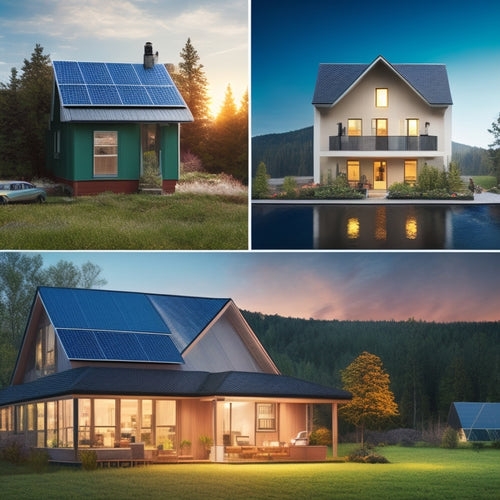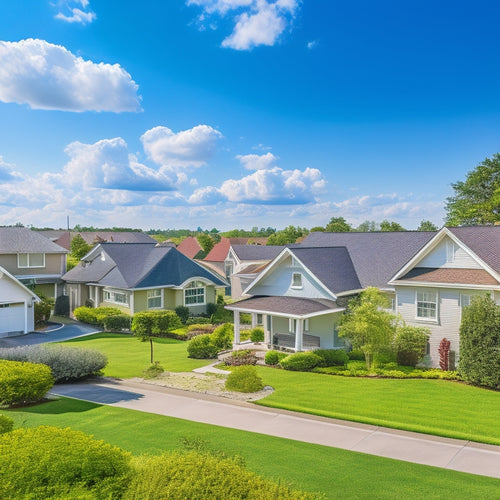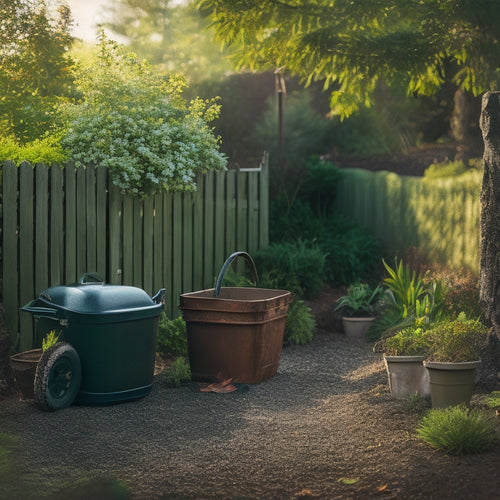
How to Optimize Home Climate for Eco-Efficiency
Share
You can enhance your home's climate for eco-efficiency by adopting a diverse approach that combines energy monitoring, smart thermostat integration, and renewable energy sources. Start by understanding your energy consumption patterns and identifying areas of improvement. Upgrading to energy-efficient appliances and improving your HVAC system can lead to significant savings. Strategic insulation techniques, climate control automation systems, and ideal temperature settings can further enhance eco-efficiency. By implementing these strategies, you'll be well on your way to creating a sustainable and environmentally friendly home climate, and there's still more to investigate to maximize your eco-friendly potential.
Key Takeaways
- Monitor energy consumption using tracking tools to identify inefficiencies and optimize energy usage.
- Upgrade to energy-efficient appliances and adopt daily habits to minimize standby power usage.
- Implement smart thermostats and temperature zones to optimize HVAC performance and enhance comfort.
- Insulate walls effectively and seal air leaks to prevent heat escape and improve energy efficiency.
- Integrate renewable energy sources, such as solar power, and energy storage solutions to reduce emissions and enhance energy independence.
Understanding Home Energy Consumption
As you flip the switch, turn the dial, or press the button, your home's energy consumption is triggered, and it's essential to understand where this energy is going.
Identifying your energy consumption patterns is key to optimizing your home's energy efficiency. Start by monitoring your energy usage to pinpoint areas of inefficiency. Check the energy labels on your appliances to determine their energy efficiency ratings.
With the rise of electric vehicles, understanding MPGe standards can also provide significant understandings into energy efficiency. Focus on upgrading to energy-efficient models, especially for frequently used devices like refrigerators and washing machines.
Additionally, adjust your daily habits to reduce standby power consumption. By comprehending your energy consumption patterns and improving home appliance efficiency, you'll be well on your way to creating a more eco-friendly living space.
Smart Thermostats and HVAC Optimization
Now that you've assessed your energy consumption patterns and upgraded your appliances, it's time to tackle the largest energy hog in your home: your heating, ventilation, and air conditioning (HVAC) system.
Smart thermostats can optimize your HVAC's performance through smart scheduling, energy forecasting, and adaptive algorithms. With remote access, you can adjust the temperature from anywhere, ensuring that your home is comfortable and energy-efficient when you need it to be.
Additionally, incorporating solar-powered charging stations can further reduce your carbon footprint and energy costs. By reducing fossil fuel dependence, you'll not only save money but also contribute to a cleaner environment.
User-friendly interfaces make it easy to create temperature zones and schedule temperature adjustments. Additionally, some smart thermostats offer demand response capabilities, allowing your HVAC to respond to grid demand and reduce energy consumption during peak hours.
Maintenance alerts also help you stay on top of filter replacements and other essential tasks. By optimizing your HVAC system, you'll save energy and enjoy a more comfortable, eco-friendly home.
Renewable Energy Source Integration
Take the next step in optimizing your home climate for eco-efficiency by tapping into renewable energy sources.
You can utilize solar panel benefits by installing a photovoltaic system, which not only reduces greenhouse gas emissions but also provides a stable energy supply, allowing you to achieve energy independence and minimize reliance on the grid.
Additionally, solar power offers high reliability compared to unpredictable grid power, with fixed costs associated with solar versus variable costs of grid power.
You can also investigate wind energy integration with a small wind turbine.
Geothermal systems can also provide a reliable source of heat and cooling.
To guarantee a steady supply of energy, consider energy storage solutions like batteries.
Many governments offer renewable energy incentives, making it more affordable to adopt these technologies.
Off-grid living is possible with microgrid technology, which allows you to generate and store your own energy.
You can also examine biomass energy options, hydroelectric power, and community solar projects to reduce your reliance on fossil fuels and increase your energy independence.
Energy-Efficient Insulation Strategies
You'll want to focus on three key areas to maximize energy efficiency through insulation: insulating your walls properly, sealing air leaks to prevent heat escape, and upgrading your window options to reduce heat transfer.
High-efficiency solar panels, which can achieve energy outputs between 18% to over 22% efficiency high-efficiency panels, can also play a considerable role in reducing your reliance on traditional power sources.
Insulate Walls Properly
Efficiency begins at the foundation, where the walls of your home serve as the primary barrier against external temperatures. To insulate them properly, consider the type of wall materials you're working with, as different materials require specific insulation techniques.
Thermal bridging, where heat escapes through gaps in the insulation, can be minimized by using continuous insulation. Moisture control is also essential, as excess moisture can compromise the insulation's effectiveness.
Additionally, insulation can provide soundproofing benefits, making your home a more comfortable space. In fact, sustainable charging solutions like those found in green energy charging infrastructure can also be applied to home insulation, reducing energy waste and carbon emissions.
By integrating eco-friendly materials and practices, you can enhance your home's climate for energy efficiency. If you're taking the DIY insulation route, follow proper installation tips to guarantee ideal energy performance.
Eco-friendly options, such as recycled denim or wool insulation, can offer cost savings while aligning with your values. By insulating your walls properly, you'll be well on your way to an eco-efficient home.
Seal Air Leaks
Around windows, doors, and electrical outlets, air leaks can greatly compromise your home's insulation, allowing heat to escape and outside air to seep in.
To maintain building envelope integrity, you must identify and seal these air leakage sources.
-
Conduct thermal imaging inspections to detect hidden air leaks.
-
Use weather stripping options and caulking materials for DIY sealing methods.
-
Consider hiring professional sealing services for complex air leaks.
- Perform seasonal maintenance tips to guarantee long-term energy loss identification and prevention.
Upgrade Window Options
Nearly 30% of heating and cooling energy is lost through windows, making them a significant contributor to energy inefficiency in homes.
You can upgrade your window options to reduce this energy loss. Consider applying window film, which provides UV protection and reduces heat transfer. Alternatively, install triple glazing or low-e coatings for improved insulation.
Energy-efficient shades and storm windows are also effective solutions. If you're due for a replacement, look for windows with these features or consider a full window replacement.
Not only will you save energy, but you'll also enjoy aesthetic enhancements, such as reduced glare and improved natural light.
Climate Control Automation Systems
In today's high-tech homes, you're likely to find climate control automation systems playing a central role in maintaining a comfortable indoor environment while minimizing energy waste.
These systems employ advanced climate sensor technology to monitor and adjust temperature, humidity, and lighting levels. With automated shading solutions, smart energy management, and remote climate control, you can enhance your home's energy consumption and reduce waste.
Some key features of climate control automation systems include:
- Integration with IoT devices for seamless connectivity
- User-friendly interfaces for easy control and monitoring
- Energy consumption forecasting for predictive maintenance
- Personalized climate settings and adaptive learning algorithms for ideal performance
Energy Monitoring and Tracking Tools
You'll want to identify your energy usage patterns to pinpoint areas for improvement, and that's where energy monitoring and tracking tools come in.
These tools provide real-time data revelations, helping you understand how and when you're using energy in your home.
Energy Usage Patterns
Tracking your energy usage patterns is essential to identifying areas of inefficiency and opportunities for improvement, as it allows you to pinpoint which devices and systems are consuming the most power throughout the day.
By understanding your usage habits and consumption trends, you can set efficiency benchmarks and identify peak demand periods.
You'll gain understanding into:
- Seasonal variations in your energy consumption
- Behavioral changes you can make to reduce energy waste
- Lifestyle adjustments that can lead to significant savings
- Utility incentives available for energy-efficient upgrades
With this knowledge, you can make informed decisions about which smart devices to invest in and how to optimize your energy usage.
Real-Time Data Insights
Monitor your energy usage in real-time with state-of-the-art energy monitoring and tracking tools, enabling you to make data-driven decisions that drive eco-efficiency in your home.
These advanced tools provide granular information into your energy consumption patterns, helping you identify areas of inefficiency and opportunities for improvement.
With real-time data analytics, you can track your energy usage in real-time, receive alerts when anomalies occur, and make adjustments on the fly.
Predictive modeling capabilities also allow you to forecast energy usage patterns, enabling you to optimize your energy usage and reduce waste.
Optimal Temperature Settings Guide
Across various regions and climates, finding the ideal temperature settings for your home can considerably impact your energy consumption and eco-efficiency.
To enhance your home climate, consider your personal temperature preferences and make seasonal adjustments accordingly.
-
Summer: Set your thermostat to 78°F (25°C) when you're away or sleeping to reduce cooling costs.
-
Winter: Lower your thermostat to 68°F (20°C) when you're away or sleeping to reduce heating costs.
-
Spring and Fall: Adjust your thermostat to 72°F (22°C) for peak comfort and energy efficiency.
- Nighttime: Lower your thermostat by 5-10°F (3-6°C) to reduce energy consumption while you sleep.
Ventilation and Air Quality Control
You'll want to guarantee your home's ventilation and air quality control systems work efficiently to maintain a healthy indoor environment.
This involves implementing air purification systems to remove pollutants, utilizing natural ventilation methods to reduce reliance on mechanical systems, and regulating air exchange rates to prevent moisture buildup.
Air Purification Systems
Within your home, a delicate balance of air quality and circulation is vital for maintaining a healthy and eco-efficient indoor climate. Air purification systems play an essential role in removing indoor pollutants and improving air quality.
You can optimize your air purification system by considering the following factors:
-
Filter types: Choose filters that capture 99.97% of particles as small as 0.3 microns to guarantee efficient removal of pollutants.
-
Purification technologies: Select systems that employ advanced technologies like HEPA, UV, or activated carbon to target specific pollutants.
-
Maintenance routines: Regularly clean and replace filters to sustain system efficiency and prevent breakdowns.
- Installation tips: Confirm proper installation to maximize system performance and minimize environmental impact.
Natural Ventilation Methods
Utilizing natural ventilation methods is a crucial aspect of maintaining an eco-efficient indoor climate, as it reduces the need for mechanical systems and promotes a healthier living space.
By employing cross ventilation techniques, you can create a consistent airflow that removes stale air and brings in fresh air. This is achieved by strategically placing windows and doors to allow air to enter and exit your home.
Additionally, the stack effect can be utilized to enhance natural ventilation. This occurs when warm air rises, creating an area of low pressure near the floor, which pulls in fresh air through windows and doors.
Air Exchange Rates
As you strive to create an eco-efficient indoor climate, maintaining ideal air exchange rates becomes essential for ventilation and air quality control. This involves implementing effective ventilation strategies to remove indoor pollutants, manage moisture levels, and introduce fresh air.
To achieve the best air exchange rates, consider the following:
-
Seasonal adjustments: Adapt your ventilation strategy according to seasonal changes to minimize energy loss and maximize natural airflow movements.
-
Energy recovery: Incorporate energy recovery systems to utilize the energy from exhaust air and transfer it to fresh air, reducing the overall energy consumption.
-
Filtration efficiency: Install high-efficiency filters to remove pollutants and contaminants, ensuring improved indoor air quality.
- Airflow movements monitoring: Regularly monitor and adjust airflow movements to prevent stagnant air and maintain a healthy indoor environment.
Energy-Star Rated Appliance Upgrades
Your home's appliances are significant contributors to its overall energy consumption, and upgrading to Energy-Star rated models can make a vital impact on your eco-efficiency goals.
By replacing old appliances with Energy-Star certified ones, you'll not only reduce your energy consumption but also extend the appliance lifespan. For instance, Energy-Star certified refrigerators use about 15% less energy than traditional models.
Upgrading to Energy-Star rated appliances can lead to significant energy savings over time. According to the U.S. Environmental Protection Agency, Energy-Star certified appliances can help you save up to $400 annually on your utility bills.
Whole-Home Energy Efficiency Audits
Beyond appliance upgrades, a thorough approach to whole-home energy efficiency is essential for achieving ideal eco-efficiency. A whole-home energy efficiency audit helps you identify areas of energy inefficiency in your home. This extensive assessment provides a roadmap for optimizing your home's energy performance.
You'll benefit from a home audit in several ways:
-
Identify energy-wasting areas: Pinpoint areas where energy is being wasted, such as air leaks, inadequate insulation, and inefficient HVAC systems.
-
Prioritize improvements: Get a clear understanding of which upgrades will have the greatest impact on your energy efficiency and budget.
-
Optimize energy usage: Learn how to optimize your energy usage habits and behaviors to reduce your energy consumption.
- Select the right energy assessment tools: Uncover the best energy assessment tools and technologies to help you achieve your eco-efficiency goals.
Frequently Asked Questions
Can I Install Solar Panels on My Roof if It's Partially Shaded?
You're wondering if partial shade kills your solar dreams? Take Sarah's example: her partially shaded roof still generates 80% of the energy with strategically placed solar panels, showcasing shaded panels aren't a deal-breaker for effective solar solutions.
Do Energy-Efficient Appliances Require Special Installation?
You don't need special installation for energy-efficient appliances, but make certain you follow manufacturer guidelines for ideal performance. Regular appliance maintenance is key to retaining energy-efficient features and maximizing their eco-friendly benefits.
How Often Should I Replace My Home's Air Filters?
You might think replacing air filters is a hassle, but it's vital for clean air and efficiency. You should swap out basic filters every 1-2 months, while HEPA and pleated filters can last 3-6 months, depending on usage and manufacturer's guidelines.
Can I Use a Programmable Thermostat With a Heat Pump?
You can use a programmable thermostat with a heat pump, but verify thermostat compatibility to maintain heat pump efficiency; check the thermostat's specifications and heat pump manufacturer's recommendations to avoid compromising performance.
Do Energy Audits Detect Water Heater Efficiency Issues?
You'll find that energy audits indeed detect water heater efficiency issues, identifying opportunities for improvement through water heater maintenance, and providing benefits like reduced energy consumption and lower utility bills.
Related Posts
-

What Does Your Home Energy Audit Report Reveal?
Your home energy audit report reveals a detailed analysis of your energy consumption patterns, highlighting areas of ...
-

What Cool Roof Tax Breaks Can Homeowners Claim?
You can claim federal tax credits of up to $500 and state and local incentives for installing cool roofs, which not o...
-

10 Green Waste Solutions Every Homeowner Should Know
You can make a significant impact on the environment by implementing green waste solutions at home. Consider composti...


